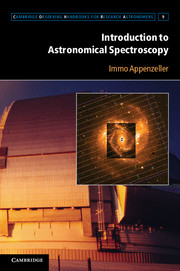Book contents
- Frontmatter
- Contents
- Preface
- 1 Historical Remarks
- 2 Spectroscopy in Present-Day Astronomy
- 3 Basic Physics of Spectral Measurements
- 4 Optical-Range Grating and Prism Spectrometers
- 5 Other Techniques for the Optical Spectral Range
- 6 Preparing and Reducing Optical Observations
- 7 UV, X-Ray, and Gamma Spectroscopy
- 8 Spectroscopy at Radio Wavelengths
- 9 Special Techniques of the FIR and Submillimeter Range
- 10 New Developments and Future Prospects
- Appendix: List of Acronyms
- References
- Index
4 - Optical-Range Grating and Prism Spectrometers
Published online by Cambridge University Press: 05 January 2013
- Frontmatter
- Contents
- Preface
- 1 Historical Remarks
- 2 Spectroscopy in Present-Day Astronomy
- 3 Basic Physics of Spectral Measurements
- 4 Optical-Range Grating and Prism Spectrometers
- 5 Other Techniques for the Optical Spectral Range
- 6 Preparing and Reducing Optical Observations
- 7 UV, X-Ray, and Gamma Spectroscopy
- 8 Spectroscopy at Radio Wavelengths
- 9 Special Techniques of the FIR and Submillimeter Range
- 10 New Developments and Future Prospects
- Appendix: List of Acronyms
- References
- Index
Summary
This chapter describes the spectroscopic techniques that are used in most near-UV, visual, and IR spectrometers. Spectroscopy in this range is particularly important for astrophysics, and instruments for these wavelengths can be constructed using conventional optical elements, such as lenses, prisms, gratings, and normal-incidence mirrors. These instruments share many common features.
Commercially Available Spectrometers
Because optical spectroscopy plays an important role in many different branches of science, medicine, and industry, many manufacturers of optical instrumentation offer commercially produced spectrometers of different types. Most of these devices are not suited for the low light levels from astronomical sources. However, in addition to some instruments that have been designed specifically for astronomical applications (mainly for amateurs), there are commercial “low light level” general-purpose spectrometers on the market, which can be (and are) operated successfully for low-resolution spectroscopy at small telescopes. These commercially available instruments have the advantage of being complete systems, which include high-quality CCD or IR detectors. In many cases they can be conveniently connected to the USB port of a computer for instrument control and data readout. Usually the light from a telescope must be fed to the spectrometer using an optical fiber (see Section 4.5), but some of these spectrometers can be attached directly to a telescope focus. Observers interested in commercially available spectrometers will have no difficulties finding the addresses of potential suppliers by searching for optical spectrometers in the Internet.
- Type
- Chapter
- Information
- Introduction to Astronomical Spectroscopy , pp. 81 - 126Publisher: Cambridge University PressPrint publication year: 2012
- 2
- Cited by

